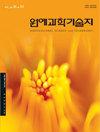Prediction of Fruit Maturity with Starch Pattern Index in Korean Apple Cultivars
IF 0.8
4区 农林科学
Q3 HORTICULTURE
Korean Journal of Horticultural Science & Technology
Pub Date : 2023-02-28
DOI:10.7235/hort.20230003
引用次数: 2
Abstract
This study was conducted to evaluate the starch loss pattern and to estimate the maturity indices and harvest time of the five Korean apple cultivars (‘RubyS’, ‘Arisoo’, ‘Hwangok’, ‘Picnic’, and ‘Colorpple’) in association with the changes of fruit quality attributes using a Cornell starch pattern index (SPI) analysis method (1-8 scores) and SPI chart development for domestic use. In 5 apple cultivars, the increase in SPI was directly related with the increase in fruit weight and soluble solids content and the decrease in flesh firmness and titratable acidity. For fruit peel coloration, the decrease in L* (indicator for brightness) and b* (indicator for yellowness) was strongly associated with the increase in SPI. In addition, the increase in a* (indicator for redness) was associated with the increase in SPI in all apple cultivars, except ‘Hwangok’, a yellow apple cultivar. A slight increase in internal ethylene concentration was also observed in all cultivars while the SPI was increased. Interestingly, the changes of SPI were different depending on each apple cultivar. Averagely, ‘RubyS’, ‘Arisoo’, ‘Hwangok’, and ‘Picnic’ apples took 3, 4, 5, and 7 days, and 7, 5, 7, and 7 days to change the SPI from 6 to 7 and from 7 to 8 scores, respectively. However, ‘Colorpple’ apple took about 10 days each to change the SPI from 6 to 7 and from 7 to 8 scores. Therefore, this study suggested that the development of SPI chart could be used as basic data to estimate the fruit maturity and harvest time of domestic apple cultivars.用淀粉模式指数预测韩国苹果品种果实成熟度
本研究采用康奈尔淀粉模式指数(Cornell starch pattern index, SPI)分析方法(1-8分)和国内应用的SPI图表,评价了5个韩国苹果品种(“RubyS”、“Arisoo”、“hwang gok”、“Picnic”和“colorapple”)的淀粉损失模式、成熟指数和收获时间与果实品质属性变化的关系。在5个苹果品种中,SPI的增加与果实重量和可溶性固形物含量的增加、果肉硬度和可滴定酸度的降低有直接关系。果皮颜色的L*(亮度指标)和b*(黄度指标)的降低与SPI的增加密切相关。此外,a*(红度指标)的增加与所有苹果品种SPI的增加有关,但黄谷品种除外。随着SPI的增加,所有品种的内乙烯浓度也略有增加。有趣的是,不同苹果品种间SPI的变化是不同的。“红宝石”、“阿里苏”、“黄谷”、“野餐”等苹果的SPI从6分变为7分、从7分变为8分,平均需要3、4、5、7天,平均需要7、5、7天。然而,“colorapple”苹果花了大约10天的时间将SPI从6分提高到7分,从7分提高到8分。因此,本研究建议,开发SPI图可作为国内苹果品种果实成熟度和采收期估算的基础数据。
本文章由计算机程序翻译,如有差异,请以英文原文为准。
求助全文
约1分钟内获得全文
求助全文
来源期刊
CiteScore
2.00
自引率
0.00%
发文量
0
审稿时长
1 months
期刊介绍:
Horticultural Science and Technology (abbr. Hortic. Sci. Technol., herein ‘HST’; ISSN, 1226-8763), one of the two official journals of the Korean Society for Horticultural Science (KSHS), was launched in 1998 to provides scientific and professional publication on technology and sciences of horticultural area. As an international journal, HST is published in English and Korean, bimonthly on the last day of even number months, and indexed in ‘SCIE’, ‘SCOPUS’ and ‘CABI’. The HST is devoted for the publication of technical and academic papers and review articles on such arears as cultivation physiology, protected horticulture, postharvest technology, genetics and breeding, tissue culture and biotechnology, and other related to vegetables, fruit, ornamental, and herbal plants.

 求助内容:
求助内容: 应助结果提醒方式:
应助结果提醒方式:


